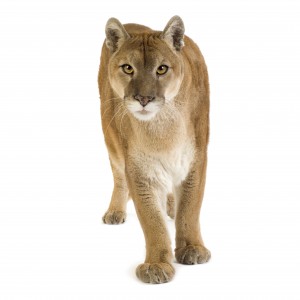Fear Induced By Predators Influences Behavior
Fear of predation causes behavioral changes. This is documented both in research and has proven true through the test of time. White tail deer living in the eastern United States changed their foraging habits from grazing and moving on to spending longer periods of time eating in place with the extinction of the Eastern Cougar. Without the top predator lurking about, the deer adapted a more relaxed dining style wreaking havoc on the ecosystem, causing soil erosion among other issues.
Up until now, little was known about the impact humans, as top predators, have on the behavior of carnivores. A recent study* investigated the influence of human-induced fear on puma foraging behavior. The study used location and prey consumption from thirty tagged puma living alongside human dominated landscapes.
Pumas Dine and Dash Out of Fear of Humans
The territory and hunting grounds of these tagged puma were identified, breaking the pumas up into two groups: those living in rural environments and those living in suburban human environments. The research team also investigated kills, measuring consumption of each kill before a puma decided to move on.
The results showed strong behavioral responses by female pumas when near human settlements.The female pumas repeated use of a kill site and the time spent consuming their prey declined when near human housing by 36 and 42% respectively. The female pumas responded to this decline in prey consumption time by increasing the number of deer they killed in housing dense locations by 36% over what they killed in areas with little human development.
This increase in predation was not due to increased hunger by the suburban pumas but is likely the result of human-induced fear. This behavior by the carnivores is analogous to the behavior of the white tail deer when sharing an ecosystem with a top predator. The behavior is similar but the environmental impact is yet to be determined. The loss of food from the decline in prey consumption along with increased energy expended to take down more prey may have ramifications for puma populations, in particular with reproductive success. In addition, more carcass availability left over from the pumas dine and dash behavior could bring in a larger number of scavengers looking for a meal.
This study sheds light on the importance of understanding the extensive and growing indirect impact of habitat modification by human activity on animal behavior. As the human population increases so does the need to understand the impact on ecosystems and the entire food web function.

Thanks for the informative post.
Sue B
We seem to study all but our own effects on the world around us. One local suburban community has a herd of at least 400 white-tailed deer and more all the time eating not only the flowers in peoples’ gardens but the imperiled species of trillium and clearing brush from steep slopes that cause roads and hillsides to collapse. We are the only predator as all others are killed off for our “safety”, creating situations like this with the puma. What to do?
another great post Joanne. the community I live in has seen an increase in coyote encroachment and some people are silly enough to ask why….uh….habitat loss.. maybe…..ya think….
Laura